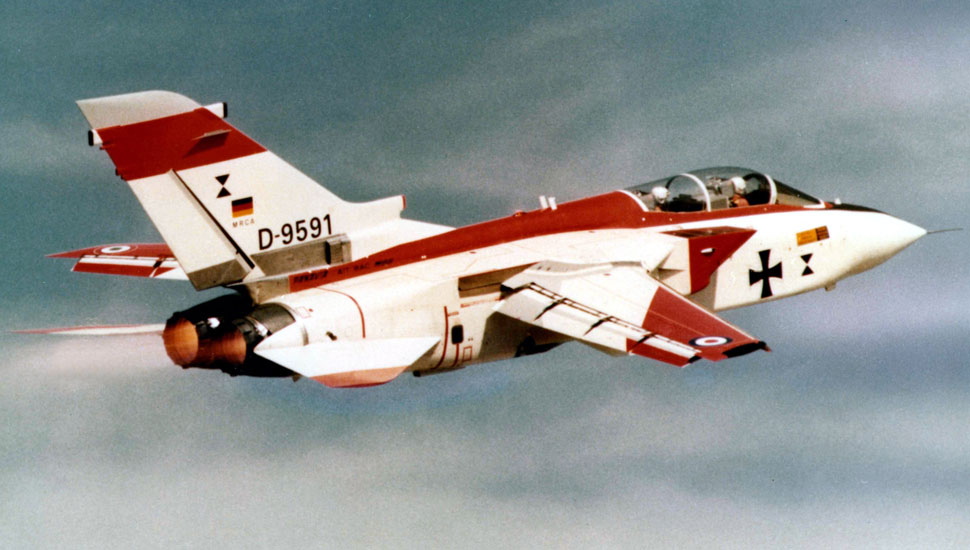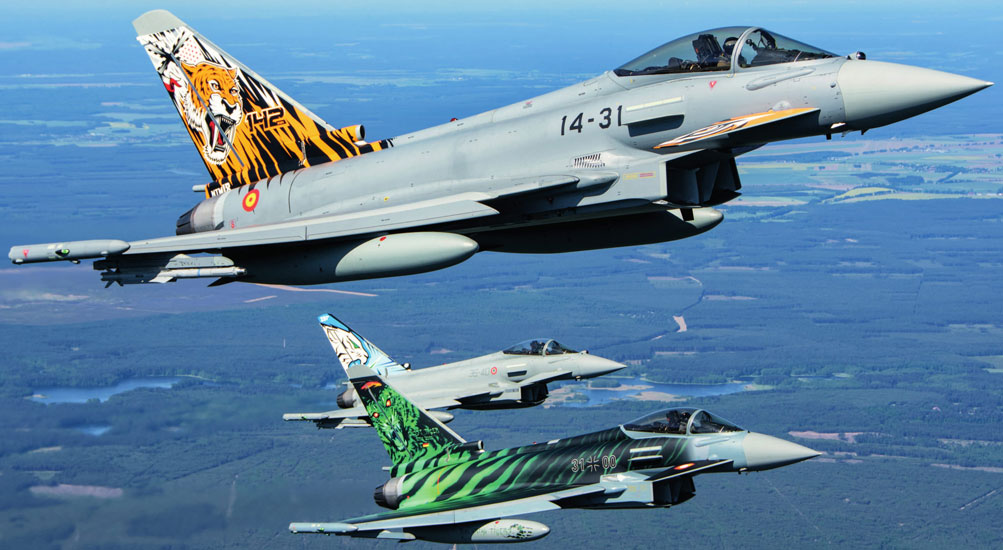Today’s Airbus Defence & Space can trace its corporate heritage back to roughly the same point as its parent company’s creation as a commercial aerospace entity, when Germany’s Messerschmitt-Bolkow-Blohm (MBB) was formed in 1969.
A European desire to advance collaborative defence programmes saw MBB take its place within an industrial grouping responsible for the development and production of a new Multi-Role Combat Aircraft (MRCA). The result of that effort – also involving Italy’s Alenia and the UK’s then-BAC – was the variable-geometry Panavia Tornado, a technological marvel of its age, combining the supersonic speed and terrain-following capability needed to support nuclear strike missions with pilot-friendly handling performance at low speed. A first prototype made its debut flight from MBB’s Manching site near Munich in August 1974.

Tornado project proved value of multinational approach
Airbus
In addition to creating a versatile combat asset, the MRCA project encouraged closer industrial alignment. In Flight International’s 26 September 1974 issue, we reported on the first display appearance of the Tornado, noting: “The spirit of European collaboration positively hung in the air in Manching”. BAC chief test pilot Paul Millett – the first to fly the type – gave his programme perspective, saying: “The whole project is conducted in a friendly atmosphere and one of mutual respect, which increases all the time.”
Germany and the UK each held a 42.5% workshare in the aircraft via the Panavia consortium, with Italy responsible for the remaining 15%. MBB manufactured the centre fuselage section for each Tornado, and performed final assembly for the German air force.
In all, 992 aircraft were built for the three partner nations, plus export buyer Saudi Arabia. The UK earlier this year retired its last GR4-model examples, but Cirium’s Fleets Analyzer shows that the Tornado remains a stalwart for its other operators, with around 270 still in use.
The MBB name remained in use for two decades before the company was subsumed by Daimler-Benz in 1989, for the creation of DaimlerChrysler Aerospace SA (DASA).
The industrial experience gained with the MRCA was later put to good effect with the European Fighter Aircraft programme, which saw Spain join the Tornado manufacturing nations in developing the Eurofighter. To date, more than 500 examples of the multi-role type have been delivered to the four partners, along with international operators Austria, Oman and Saudi Arabia. The Typhoon is also currently in production for Kuwait and Qatar, and further sales are anticipated, with multiple opportunities being pursued by Airbus, BAE Systems and Leonardo.

Eurofighter saw Spain coming into manufacturing mix
Giovanni Colla/Eurofighter
Another major pillar of the modern-day Airbus Defence & Space is its extensive military airlifter product range, which ranges in size from the C295 medium transport to the tactical A400M Atlas and its A330 widebody-derived multi-role tanker/transport (MRTT).
This unit’s origins date back to the C212 Aviocar, first flown by Spain’s CASA in 1971. The company, with production activities at the San Pablo site near Seville, was merged with DASA in 1999, along with France’s Aerospatiale Matra, to create EADS. Subsequently operating as Airbus Military, its key task was to deliver Europe’s A400M as a successor for the Franco-German Transall and Lockheed C-130.
After a long gestation, a combined development and production contract was signed in May 2003 with the multinational OCCAR defence procurement agency, on behalf of Belgium, France, Germany, Luxembourg, Spain, Turkey and the UK. The first delivery was made in late 2013, and in the first quarter of this year Airbus shipped its 75th example, from a combined European commitment for 170.
The A400M has weighed heavily on Airbus over the past several years, due to development challenges and the delayed addition of promised tactical capabilities, which have resulted in financial penalties. The enormity of this contractual mire only became fully apparent well into the project, with the company’s own history page rather understatedly noting: “Airbus set the bar high in terms of technical and programme complexity”.

A400M programme has been beset by development snags
Messe Berlin
Challenges included the pursuit of certification not only from military authorities, but also via the European Union Aviation Safety Agency. The airframer also struggled due to an over-ambitious development schedule and as a result of the type’s Europrop International TP400-D6 turboprop engine, for which the company had assumed overall responsibility.
Not disguising his frustration as Airbus called for a “re-baselining” of the programme in 2017, then-group chief executive Tom Enders described its signature of the single development and production contract as an “original sin”. The company hopes that discussions over a revised deal will finally conclude around mid-2019.
Meanwhile, the C295 – a stretched and improved development of the CN235 model first flown in 1983 – has established itself as the market leader in its class.
The A330 MRTT has also been a strong performer, with sales made to Australia, France, Saudi Arabia, Singapore, South Korea, the UK, the United Arab Emirates and a multinational group of NATO nations so far comprising Belgium, Germany, Luxembourg, the Netherlands and Norway. The twinjet – which boasts a 111t fuel capacity and the ability to carry up to 300 passengers – also won selection for the US Air Force’s original KC-X requirement, but ultimately lost out to Boeing’s 767-derived KC-46A Pegasus for the 179-aircraft contract.
Opportunities are now being sought for further military derivatives of Airbus’s commercial products. A proposed modular multi-mission – or M3 – development of the A320neo, intended to perform roles such as maritime patrol, is gaining early momentum, with France and Germany needing to replace their ageing fleets of Dassault Atlantics and Lockheed P-3s in the coming years. The type could also be adapted for airborne early warning (AEW) and intelligence-gathering tasks, Airbus believes.
Any future success would come on top of the more than 1,800 military aircraft ordered from Airbus’s defence arm over recent decades. The company says more than 1,600 have been delivered to date, with around 1,300 of these still in operational service.
Another strong focus area for Airbus is unmanned air vehicles (UAVs), ranging from its use of Israel Aerospace Industries Heron 1s on intelligence, surveillance and reconnaissance missions supporting the German military, to developing its own products. Having proved key technologies with its Barracuda unmanned combat air vehicle demonstrator, it is now advancing long-held ambitions to develop a European medium-altitude, long-endurance system in conjunction with industry partners across the continent. After a false dawn with its Talarion concept, championed during the company’s short-lived Cassidian era, the programme is now advancing via a pact also involving France, Italy and Spain.
Other examples of innovative Airbus defence products – such as a proposed AEW version of the C295 explored with Israeli industry, and the Mako high-energy advanced trainer – have impressed, but failed to make it to in-service status.
Meanwhile, efforts to boost European industrial collaboration have flourished with MBDA, the group’s its largest guided weapons company. Airbus has a 37.5% holding in the manufacturer, with its stake equal to that of BAE, and with Leonardo accounting for the remaining 25%. With products including the Storm Shadow cruise missile and beyond-visual-range Meteor air-to-air missile, MBDA reported sales worth €4 billion ($4.4 billion) last year.
Today, Airbus is the largest defence company in Europe, with 33,000 employees working at 16 production sites and with a presence in Finland, France, Germany, Italy, the Netherlands, Norway, Poland, Spain and the UK. In addition to its military aircraft activities, which produced 52% of its revenue last year, its business also includes space systems and a communications, intelligence and security arm, also covering cyber activities.
And the company could have grown larger still, had European legislators and governments backed a suggested merger with BAE, which was formally abandoned in 2013.
It has rationalised its activities over recent years as part of Airbus’s wider efficiency drive, notably divesting its Defence Electronics business to Germany’s KKR. Completed in February 2017, this deal led to the emergence of radar and sensor house Hensoldt. Airbus transferred its last holding in the company in September 2018.
“After streamlining our portfolio we are now well positioned, with a clear focus on smarter products, more service-based offerings and accelerating digital innovation,” Airbus Defence & Space chief executive Dirk Hoke said of the sale.
In terms of business performance, the defence arm recorded sales worth €8.4 billion in 2018, ending the year with an order backlog worth more than €35.3 billion. In revenue terms it brought in 17% of Airbus’s total earnings, compared with 74% from its commercial business.
Looking ahead, a potentially key Future Combat Air System (FCAS) concept launched by France and Germany could further reduce duplication of effort between Airbus and Dassault in the fighter arena.
Hoke points to the huge potential of the pact in both commercial and collaborative terms, saying: “FCAS is one of the most ambitious European defence programmes of the century. Both companies are committed to providing the best solutions to our nations with regard to the new-generation fighter, as well as the systems of systems accompanying it.” This is likely to also include combat UAVs and strike weapons.
Spain has already joined the effort, and Enders earlier this year repeated his desire for the UK to also consider getting involved. “By no means are we of the opinion that this should be a closed shop for the French and the Germans – I very much hope that after all the history, legacy and good experience we have working with our British partners on the Typhoon that eventually it will make a lot of sense to join, to build one strong programme in Europe,” he said.
But despite the significant level of defence industry consolidation so far achieved in Europe, the sector now appears highly balanced, with the preservation of several national champions: Airbus in France, Germany and Spain, plus BAE in the UK, Leonardo in Italy and for Sweden, Saab.
In Enders’ words, Airbus has successfully transformed what was once “a conglomerate of various bits and pieces from France, Germany, Spain and the UK: different brands – different fiefdoms.” He adds: “We have shown what Europe can achieve when it works together.”
For Hoke and his colleagues, the challenge now facing Airbus’s defence unit is to turn the “overall stable business performance” of today into something more akin to the stellar success of its commercial arm.
Read every story celebrating the 50th anniversary of Airbus here
Source: FlightGlobal.com



















